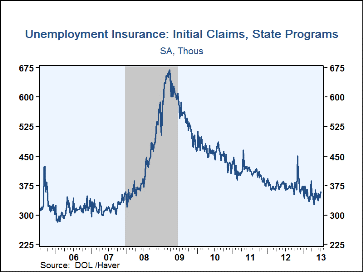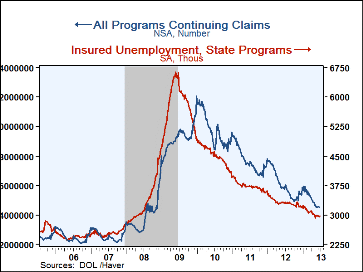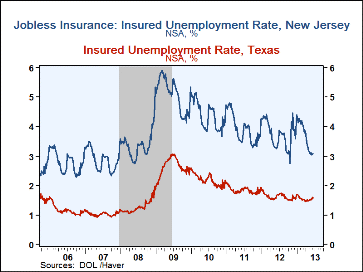 Global| Jul 11 2013
Global| Jul 11 2013U.S. Initial Unemployment Insurance Claims Surprisingly Move Higher
by:Tom Moeller
|in:Economy in Brief
Summary
First time claims for unemployment insurance increased to 360,000 (-0.8% y/y) during the week ended July 6 from a little-revised 344,000 during the week prior. Consensus expectations were for 335,000 claims. The four week moving [...]
First time claims for unemployment insurance increased to 360,000 (-0.8% y/y) during the week ended July 6 from a little-revised 344,000 during the week prior. Consensus expectations were for 335,000 claims. The four week moving average of claims rose to 351,750, its highest level since late-May. During the last ten years, there has been a 74% correlation between the level of claims and the m/m change in nonfarm payrolls.
Continuing claims for unemployment insurance in the week ended June 29 backed up slightly to 2.977 million (-10.1% y/y) from 2.953 million. The four week moving average of continuing claims slipped to a cycle-low of 2.971 million. The insured rate of unemployment held at 2.3%, where it's been since early-April. This particular count covers only "regular" programs and does not include all extended benefit and other specialized jobless insurance programs. In the week of June 22, the latest figure available, the grand total of all benefit recipients slipped w/w at 4.506 million, (-23.3% y/y). That compares to a cycle peak of 12.060 million in January 2010. The number of individuals who were collecting emergency and extended payments fell to a cycle low of 1.645 million (-36.9% y/y).
By state, the insured rate of unemployment continued to vary greatly with South Dakota (0.44%), Virginia (1.25%), Oklahoma (1.40%), Indiana (1.53%), Texas (1.59%), Ohio (1.61%), Tennessee (1.67%) and Georgia (1.68%) at the low end of the range. At the high end were Michigan (1.88%), Massachusetts (2.30%), New York (2.53%), Illinois (2.61%), Nevada (2.79%), California (3.01%), New Jersey (3.09%) and Pennsylvania (3.15%).
Data on weekly unemployment insurance are contained in Haver's WEEKLY database and they are summarized monthly in USECON. Data for individual states are in REGIONW. The consensus estimates come from the Action Economics survey, carried in the AS1REPNA database.
The minutes to the latest FOMC meeting can be found here.
| Unemployment Insurance (000s) | 07/06/13 | 06/29/13 | 06/22/13 | Y/Y % | 2012 | 2011 | 2010 |
|---|---|---|---|---|---|---|---|
| Initial Claims | 360 | 344 | 348 | -0.8 | 375 | 409 | 459 |
| Continuing Claims | -- | 2,977 | 2,953 | -10.1 | 3,318 | 3,744 | 4,544 |
| Insured Unemployment Rate (%) | -- | 2.3 | 2.3 | 2.6 (6/12) |
2.6 | 3.0 | 3.6 |
| Total "All Programs" (NSA) | -- | -- | 4.506 mil. | -23.3 | 6.047M | 7.750M | 9.850M |
Tom Moeller
AuthorMore in Author Profile »Prior to joining Haver Analytics in 2000, Mr. Moeller worked as the Economist at Chancellor Capital Management from 1985 to 1999. There, he developed comprehensive economic forecasts and interpreted economic data for equity and fixed income portfolio managers. Also at Chancellor, Mr. Moeller worked as an equity analyst and was responsible for researching and rating companies in the economically sensitive automobile and housing industries for investment in Chancellor’s equity portfolio. Prior to joining Chancellor, Mr. Moeller was an Economist at Citibank from 1979 to 1984. He also analyzed pricing behavior in the metals industry for the Council on Wage and Price Stability in Washington, D.C. In 1999, Mr. Moeller received the award for most accurate forecast from the Forecasters' Club of New York. From 1990 to 1992 he was President of the New York Association for Business Economists. Mr. Moeller earned an M.B.A. in Finance from Fordham University, where he graduated in 1987. He holds a Bachelor of Arts in Economics from George Washington University.










